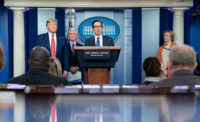Coronavirus and Construction
Update: New Directive Eases Path for Smaller Paycheck Protection Loans
Treasury-SBA Guideline Applies to PPP Loans Under $2 Million
In a positive move for small engineering and construction companies—and those in other industries—federal agencies say forgivable loans less than $2 million under the Paycheck Protection Program are acceptable and won’t face federal audits or reviews. The Associated General Contractors of America and the American Council of Engineering Companies say the majority of PPP loans to their association members are smaller than $2 million.
Engineering and contractor groups welcomed the new guidelines—which the Treasury Dept. and Small Business Administration issued on May 13—but said other guidance is needed in implementing PPP. [See new guidance here, in FAQ #46.] The guidelines include specifics about how the loan forgiveness process will work and clarifications for firms with loans $2 million or larger.
The two agencies also moved the deadline to May 18 for companies to repay their loans to the government if they don't think they are in compliance with the PPP requirements. The deadline had been May 14.
Congress created the PPP in the Coronavirus Aid, Relief and Economic Security, or CARES, Act, which President Trump signed into law March 27. The law included $349 billion for the program, which aimed to assist small companies—those with fewer than 500 workers—cope with the financial burdens from the COVID-19 pandemic.
The SBA launched the PPP on April 3 and ran out of money in 13 days. Congress added $310 billion to PPP in a follow-up measure, enacted on April 24.
AGC, ACEC. ABC Reactions
Despite the need for more clarity, Stephen E. Sandherr, Associated General Contractors of America’s chief executive officer, said the new Treasury-SBA directive “will clearly help save many jobs.”
Sandherr said in a statement the agencies' action “offers the kind of guidance we have been seeking" and "provides many employers with additional clarity on how to proceed with their loans.”
But Sandherr said the guidance “does leave several important questions unanswered, including about the timing and condition of those possible loan repayments.”
Jeff Urbanchuk, a spokesman for the American Council of Engineering Companies, said via email, “From our perspective, this is a good first step in clarifying for a significant number of loan recipients that they met the good-faith certification test on the PPP loan application.”
But Urbanchuk added the association wants SBA to ensure that firms with larger loans can still certify for a loan based on the information available when they applied for the loan.
A new ACEC survey shows that 86% of responding firms were approved for loans of $2 million or less.
But 96% of ACEC firms with PPP loans with a workforce or 200 or more said their loan amount exceeded $2 million, according to the survey.
Peter Comstock, Associated Builders and Contractors director of legislative affairs, says, “I think [the guidance] certainly addresses some of the urgency that companies may have had about whether they need to return the money, and how quickly.”
Comstock said in an interview that ABC has heard from some member companies with loans of $2 million or less that see the new guidance as beneficial, adding, “It addresses a lot of their concerns.”
ABC also says additional guidance is needed. Comstock says, for example, that further clarification is “long overdue” for how firms should apply for loan forgiveness.
To gain full forgiveness for the loan, borrowers must only spend the proceeds on certain items, such as payroll, rent and utility costs, with 75% of the loan dollars going to payroll.
Comstock says questions remain about guidelines issued on April 28 that tightened PPP loan requirements. In particular, he cites a provision that applicants must take into account “their ability to access other sources of liquidity.” He says it's unclear whether the "sources of liquidity" include such things as lines of credit or access to the capital markets. [View ENR 5/1/2020 story on worries caused by April 28 guidelines here.]
As of late afternoon May 13, SBA reported it had approved about 2.7 million loans totaling $192.6 billion in the second round of PPP.
Rubio supports new approach
The day before Treasury and SBA issued the new directive, Senate Small Business Committee Chairman Marco Rubio (R-Fla.), a main architect of the Paycheck Protection Program, voiced support for the $2-million threshold approach.
Rubio told Treasury Secretary Steven Mnuchin and SBA Administrator Jovita Carranza in a May 12 letter, "I would support a broad declaration that all loans under $2 million will be presumed to have been applied for in good faith."
Rubio also suggested a test for those with loans of $2 million or more. He wrote to Mnuchin and Carranza that if borrowers at that level demonstrate that they didn't lay off workers they should be presumed to have taken the loan in good faith.
On the other hand, Rubio said, if a PPP borrower did lay off workers, "then it should be presumed that they did not apply for the loan to maintain payroll, but rather as a source of credit on highly favorable terms for a firm of their size."
Story updated on 5/14/2020 with new loan repayment deadline, letter from Senator Rubio.


